excitement
One of the main points of optimism around these parts when it comes to the basketball team is its youth. Young players are usually not so efficient, usually not so safe with the ball, and teams featuring swaths of them usually don't play very well unless they're about to get some Final Fours vacated up in here.
Earlier this year I made the case that when people point to the ill-fated '09 team as a reason to rein your excitement in they weren't necessarily wrong, but they weren't necessarily right, either. Citing a Big Ten Geeks study that showed going from freshman to sophomore results in more improvement than going from a sophomore to senior, I pointed out how absurdly young Michigan was in not only minutes but in usage:
In 2009 freshmen played 31% of Michigan's minutes. This year it's 44%.
What's more, the second and third highest usage guys on the team are freshmen who play at least 60% of minutes. In 2009 Douglass and Novak had low usage and Laval Lucas-Perry was a mid-year transfer who only played 33.% of Michigan's minutes. The percentage of possessions used by freshman this year is vastly higher. Two years ago: 26%. Now: 45%.
Now that the season's over we've got a bit of an issue, though: Tim Hardaway did not have an average freshman year, nor did Jordan Morgan. We can expect Generic Freshman to improve a lot, but what about Incredible Freshman? The threat of regression to the mean looms.
The guys at Big Ten Geeks were kind enough to provide the raw data that they used for that study and I've set about whittling it down. My first thought was that I would chart freshman and sophomore ORtgs and throw together a polynomial trendline that would probably show guys who start off with a bang like Hardaway and Morgan improve a lot less than guys like Adreian Payne, the hyped MSU freshman who struggled to an 89.5 ORtg—horrible—in about nine minutes a game this year, because of regression and getting better quickly etc etc. That didn't come off because the data is a giant hairball.
Next idea: let's whittle down the data set to freshmen with profiles similar to Michigan's freshman trio and see what happened as sophomores. The Geeks study looks at minutes, ORtg, shot%, eFG%, and TO% from players who entered BCS conferences from 2000 to 2005. Only conference games are considered, which is fine for the Geeks' refinement of a vast lump of data but maybe not so good when we're looking at individual players on which we don't have a ton of info. I'm using the entire freshman seasons for Hardaway, Morgan, and Smotrycz; I'll point out conference numbers for each.
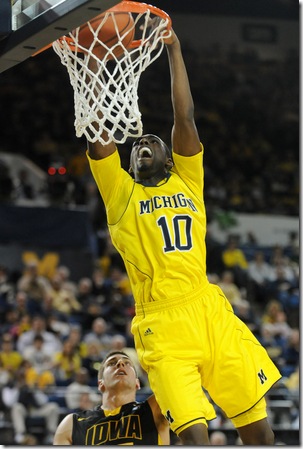 Tim Hardaway, Jr.
Tim Hardaway, Jr.
| Min% | ORtg | Shot% | eFG | TO% |
|---|---|---|---|---|
| 76.2 | 108.8 | 26.3 | 52.0 | 11.1 |
- JJ Redick (Duke): 115 ORtg
- Tyler Hansbrough (UNC): 120
- Chris Lofton (Tennessee): 128
- Anthony Roberson (Florida): 115
- Craig Smith (BC): 113 with 29 shot%
- Chris Taft (Pitt): 112 with 28 shot%
These guys* are in Hardaway's range:
- Darius Rice(Miami): 110
- Rick Rickert(Minnesota): 112
- Caron Butler(UConn): 110
- Kevin Pittsnogle(Yes That Pittsnogle): 107
- Mike Sweetney (Georgetown): 108
- Dominic James (Marquette): 107
- Aaron Bruce (Baylor): 107
I probably don't have to tell you about Butler, Sweetney, or Pittsnogle. Darius Rice actually sat out his freshman year as a non-qualifier; he was Miami's star player for the entirety of his career. Rickert was kind of a headcase, entered the NBA draft after his sophomore year, got punched by Kevin Garnett, and became an Australasian National Basketball League All Star. James had an explosive freshman year but turned into Bracey Wright afterwards and eventually didn't get drafted.
Bruce is from Australia (seriously) and his career, like his toilet, went in reverse: he was awesome as a freshman but his minutes, points, an efficiency steadily declined over the course of his career, or at least would have if he didn't shoot 33% on twos as a sophomore despite being a 40% three point shooter. What happened? Well, Baylor almost got the death penalty because their coach covered up a murder. Baylor's nonconference schedule was cancelled. So… yeah. That's kind of an outlier. Let's drop him.
What happened to the guys in the range as sophomores? Here's a table. I bolded improvements.
| Team | Player | Min Delta | ORtg Delta | Shot% Delta | eFG Delta | TO Delta |
|---|---|---|---|---|---|---|
| Mia | Rice | 1.2 | -3.3 | 1.5 | -2.5 | -0.4 |
| Minn | Rickert | 11.3 | -8.4 | 4.9 | -8.4 | -6.9 |
| UConn | Butler | 14.4 | 3.4 | 4.0 | 5.9 | -0.3 |
| GTown | Sweetney | 14.0 | 6.1 | -2.1 | -0.5 | 0.3 |
| Marq | James | 6.4 | -8.1 | -0.9 | -11.7 | -2.2 |
| WVU | Pittsnogle | -10.5 | -1.1 | 4.5 | 0.0 | -0.3 |
| AVERAGE | 7.1 | -1.6 | 2.1 | -2.9 | -1.9 |
On the whole they shot more but less effectively, turned it over slightly less, and played slightly more. Individually, James collapsed and Rickert turned into Dion Harris (apparently except punchable). Rice ended up treading water.
Pittsnogle was a heroic, heroic shooter to keep up his 53.6(!) eFG rate while launching almost a third(!) of WVU shots when he was on the floor but didn't even start. Someone should ask Beilein how he could have played a guy who shot 50% from 2 and 43% from 3 less than 20 minutes a game in 2005-06. Butler and Sweetney took major steps forward, especially Butler. Butler was off to the lottery; Sweetney stuck around, then got drafted in the top ten.
The Upshot
Tim Hardaway's freshman season was ridiculous, and as a bouncy 6'5" wing forward his closet comparable on the list is Caron Butler. Unfortunately, Michigan can't expect him to do what Butler did—that leap in production is Morris-like and obviously an outlier—and his cohort ran in place as sophomores, losing efficiency but taking more of the load. His late-season improvement suggests he's already better than his full year numbers indicate, though, and while he can't add many minutes he can maintain his shooting over the course of the season and become more of an assist guy as he develops a drive to the bucket.
*[Ed: The dataset included Carl Landry, a JUCO transfer, and former UGA guard Ezra Williams. I dropped Landry for obvious reasons and after looking Williams up on the internet I think there's an error somewhere. ESPN shows no games for him; Statsheet shows a 42% FG shooter who shot 30% from 3 and had 2 assists per game, so his shiny ORtg seems improbable. The dataset also shows Williams dropping ORtg at the same time Statsheet says he went from a 30% three point shooter to 40% while nearly doubling his attempts. Not sure if that's a data error or just an amazingly strong effect from dropping nonconference games; either way I think his individual case is not representative. He was a good, not great, college player FWIW.]
Jordan Morgan
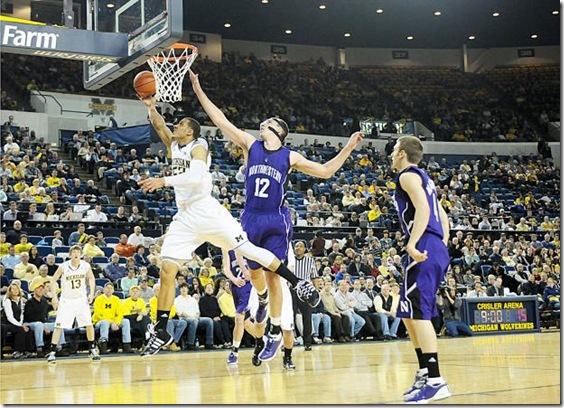
| Min% | ORtg | Shot% | eFG | TO% |
|---|---|---|---|---|
| 59.6 | 109.0 | 20 | 62.7 | 19.2 |
Morgan doesn't narrow down the dataset quite as extensively but he's not far off. His parameters: >50% minutes, ORtg between 106 and 112, Shot% between 18 and 22. Results: a list of 13 players featuring Dee Brown, Devin Harris, Rajon Rondo, Courtney Sims, Josh Shipp, Ryan Gomes, and some guy named Williams who played for UNC I'm pretty sure is named Jawad but can't be certain. The average player on the list was awesome in college. Morgan crushed all of them in eFG% save Colorado C, McDonald's All-American, and eventual first round pick David Harrison. This is a tribute to Beilein, Morgan, and especially Darius Morris.
We've got some more names here so let's narrow it down to forward/center types. We'll add in an average for all 13 players as well. Those guys:
| Team | Player | Min Delta | ORtg Delta | Shot% Delta | eFG Delta | TO Delta |
|---|---|---|---|---|---|---|
| Colorado | David Harrison | 2.7 | -7.9 | 0.4 | -16.9 | -4.7 |
| LSU | Brandon Bass | -6.8 | 7.4 | 4.5 | 5.8 | -2.6 |
| Prov | Ryan Gomes | 0 | 2.0 | 5.7 | -2.1 | 1.4 |
| Mich | Courtney Sims | -0.5 | -11.2 | 1.4 | 0.3 | 8 |
| AVERAGE | just the posts | -1.2 | -2.4 | 3.0 | -3.2 | 0.5 |
| ALL | all 13 | 4.0 | -1.2 | 3.0 | -2.3 | -1.3 |
You know all about Sims and his infuriating career. As a sophomore his TO% shot from a bad 17.5 to an impossible 25.5; he only played half the available minutes each year. He'd end up randomly dominating four games every year, then disappearing for long stretches.
Harrison's massive eFG% regression was all but inevitable after he put up a 66.1 as a freshman. He bounced back to near-freshman numbers the next year and ended up a late first round pick. Bass blew up, left for the draft, and went at the top of the second round. Gomes got better, then just kept getting better. After going 0 for 3 from three in his first two years at Providence he was a 38% three-point shooter as a senior. He was drafted at the tail end of the second round but stuck in the NBA; he's now a Clipper. He's averaged about 12 points a game the last few years.
The Upshot
These are all very good college players (and Courtney Sims), but I think we all know a significant chunk of Morgan's production would not exist if he wasn't running the pick and roll with Darius Morris. His cohort ran in place and the posts actually took a small step back. Harrison's eFG% change is a bit ominous, since he's the only player on the list with a number anywhere near Morgan's insane 63%.
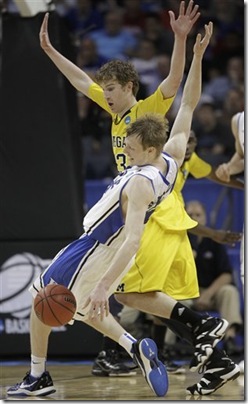 Evan Smotrycz
Evan Smotrycz
| Min% | ORtg | Shot% | eFG | TO% |
|---|---|---|---|---|
| 44.2 | 99.8 | 23 | 51.8 | 15.4 |
Smotrycz drops to a 96 ORtg—one spot worse than Douglass—in conference play.
I thought Smotrycz's relatively pedestrian numbers would bring a flood of candidates but when you look for guys with between 35 and 55 percent of minutes, an ORtg between 96 and 102, and a shot percentage between 21 and 25 you only get eight players.
There are ten that popped up but I chucked out a couple of JUCO transfers for obvious reasons. One, former FSU guard Monte Cummings, was in the army, served a tour of duty in Bosnia, and then hit FSU at 24. He's now in the Finnish league but got in some trouble for weed. He has a more interesting life than you do.
Anway, this is a less notable group of names but the good news is they collectively blew up as sophomores:
| Team | Player | Min Delta | ORtg Delta | Shot% Delta | eFG Delta | TO Delta |
|---|---|---|---|---|---|---|
| Bama | Alonzo Gee | 18.6 | -7.7 | 1.9 | -15.5 | -5.1 |
| Stanford | Lawrence Hill | 40.5 | 22.6 | 5.0 | 12.3 | -1.3 |
| Stanford | Josh Childress | 32.8 | 9.7 | 1.9 | 0.6 | -2.5 |
| Oregon | Luke Jackson | 17.8 | 22.0 | 3.6 | 6.8 | -6.1 |
| Nova | Allan Ray | 14 | 17.5 | 8 | 10.7 | -3.6 |
| Rutgers | JR Inman | 34.3 | -6.4 | 4.1 | -9.6 | -2.0 |
| Kansas | Julian Wright | 23.0 | 6.3 | 1.2 | -5.0 | -4.6 |
| BC | Sean Marshall | 1.4 | 6.3 | 3.5 | 5.2 | -1.2 |
| AVERAGE | 22.8 | 8.8 | 3.7 | 0.7 | -3.3 |
(Only Ray and Gee were above 100 as freshmen here, so the numbers are biased towards the lower end of the range—even if you take Smotrycz's conference numbers this is a pretty fair comparison.)
So that's a bunch of guys who got insanely better, Gee, and one guy (Inman) who took to Facebook to accuse his former head coach of "cook[ing] a steak of turmoil" for ruining his senior year, seemingly because he can't play basketball.
The Upshot
It's probably not realistic to expect Smotrycz to see all of the vast improvement his cohort did because I'm betting all of the players above played on teams that lost players in the offseason. If Darius Morris does what it seems the world expects him to that won't be the case at Michigan and Smotrycz isn't suddenly going to be logging 85% of Michigan's minutes. However, there's no reason he can't be significantly more efficient even if he's coming off the bench.
Collective Upshot
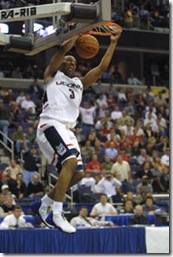
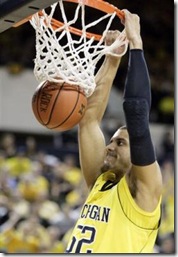
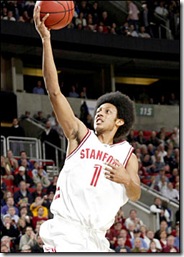
Caron Butler, Jordan Morgan, and Josh Childress
The freshmen == improvement meme gets a little sketchy once you get into the rarefied air Morgan and Hardaway reside in. Both of their cohorts essentially didn't improve at all. They didn't get worse—increased usage is naturally paired with decreased ORtg—but each leap into the stratosphere was coupled with one guy treading water and one guy regressing badly.
Michigan fans who watched the two guys play all year know who is who in that situation. Morgan is probably going to tread water. His offense is dependent on other players, his eFG% already massive, and his athleticism is just okay. He's likely to regress to the mean in his shooting and while he'll cut down on the turnovers* and up other bits of his game all that adds up to pretty much the same guy. His improvement will have to come on the defensive end (read: STOP FOULING).
Hardaway, on the other hand, exists in even more rarefied air if you look at the tougher conference schedule. His three point shooting streak extends over the second, tougher half of an entire frickin' year and he's got the physical ability to dominate his position, unlike Morgan. Also his dad is Tim Hardaway.
As for Smotrycz, everyone's giving him an owlish look and hoping he spends the offseason sleeping in the gym so he can be the guy he was supposed to be after he blew up on the AAU circuit two summers ago. His cohort saw three people turn into All-American-type players, three people get a lot better and two guys regress. Split the difference and Michigan should be able to expect efficiency out of him similar to what they got out of Hardaway this year, albeit at considerably reduced usage. Josh Childress is a bit much, but of Michigan's three freshmen he's the most likely to look like a different player next year.
*[Of course Courtney Sims is the lone significant exception to this rule. Argh.]
25